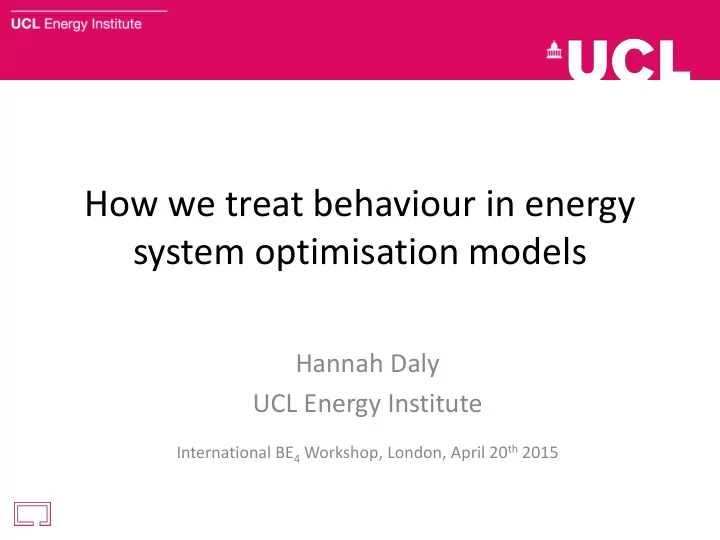

How we treat behaviour in energy system optimisation models Hannah Daly UCL Energy Institute International BE 4 Workshop, London, April 20 th 2015
1. Parameters which capture behaviour in ESOMs 2. Use of hurdle rates 3. Sensitivity analysis of hurdle rates 4. An empirical basis for hurdle rates
Parameters which capture “behaviour” in ESOMs • Energy system optimisation models • Whole-energy system depiction • Technology explicit/detailed • Linear programming basis: • Minimising costs, or • Maximising surplus • “Social planner” perspective • Whole-energy system depiction • Technology explicit/detailed • Linear programming basis: • Minimising costs, or • Maximising surplus • “Social planner” perspective
Parameters which capture “behaviour” in ESOMs Energy service demand Technology uptake & use Passenger kilometers, lumens, heat, etc. 1. Demand driver 3. Discount and hurdle rates Source: Simple econometric models Government/authoritative projections Other models 2. Elasticity of demand • Whole-energy system depiction Demand response to price • Technology explicit/detailed Determined by income, substitutability • Linear programming basis: and necessity of good, etc • Minimising costs, or • Maximising surplus • “Social planner” perspective
Discount & hurdle rates • Global discount rate: – Applied globally across the model – Prescriptive/”ethical” discounting: 0.11% -3.5% • Represents value society attaches to present over future consumption or utility – Descriptive/behavioural: 10% • Reflects real market risk, required rate-of-return • Technology- specific discount rate, “ h urdle rate” – Applied to specific sectors or technologies – Can differentiate the agent making investment • Private cost of capital 7-10% • Business borrowing costs: 3-7% • Government: 1%? – Can also represent • the required rate of return on investment (10-15%?) • the perceived energy-efficiency gap of individuals => 25% • Other uses for representing behaviour
Use of hurdle rates • One study (global HR 10%, end-use 25%) • Market investment rate. "to reflect commercial UK market rates of return" • "higher technology-specific discount or hurdle rate to account for market risks and consumer preferences” • "imperfect knowledge and non-cost preferences" • "market risk, information deficiencies and other market imperfections in the uptake of end-use conservation options" • Another study: • Hurdle rates are “used for both the cost of finance and for social discounting. The first is … in accordance to an annual return on investment. Social discounting is used to reflect the valuation on well- being in the near future versus well-being in the longer term”
Use of hurdle rates (cont’d) • A third: • High hurdle rates are used for new/unproven technologies: “a factor of 15% to reflect a higher risk in investing in unproven technologies and infrastructures” • “meant to mimic hesitancy on the part of the purchaser to invest in a newer technology over an established technology” • "Hurdle rates of 25, 20, and 15% are applied, graded on dates of commercial availability, the severity of perceived market barriers, and the uncertain requirements of new infrastructures"
Average hurdle rates for residential energy efficiency investments Manion et al., 2006 “ Strategic Investments in Residential Energy Efficiency: Insights from NE MARKAL “
MARKAL/MAC PRIMES/JRC DECC DDM TIMES UKTM ESME UK RO Upstream / 10% 8% 7% 10% 10% Processes Inconsistency in the portrayal of: Power sector 10% 8% 9% 10% 5-19% • Individual purchaser behaviour Agriculture 10% 8% 12% 10% 10% – Energy Efficiency gap, vs low cost of borrowing Industry 10% 8% 12% 10% 10% Services 10% 8% 12% 10% 10% • Novel technologies • High cost of uncertainty, Residential 5% 8% 18% 25% 5% vs “technology agnostic” Cars 5% 8% 18% 25% 5% Public 7% 8% 8% 25% 7% transport Road freight 10% 8% 12% 9% 10% Aviation 10% 8% 8% 4% 10% Shipping 10% 8% 12% 4% 10%
Sensitivity analysis with the UK TIMES Model (UKTM)
Power Generation Mix UKTM Base DECC - DDM 80 70 70 60 60 50 50 GW 40 40 GW 30 30 20 20 10 10 0 0 No Hurdle Rates 90 Imports Hydrogen 80 Nuclear Hydro 70 Geothermal Wave 60 Wind Tidal 50 GW Solar Biomass CCS 40 30 Biomass Manufactured fuels 20 OIL CCS Oil 10 Natural Gas CCS Natural Gas 0 Coal CCS Coal
Passenger car fuel consumption UKTM-base MARKAL Macro 600 600 500 500 400 400 PJ 300 300 200 200 100 100 PJ 0 0 CNG LPG Hydrogen No Hurdle Rates 600 HEV Petrol EV 500 E85 Diesel CFV 400 PJ 300 200 100 0
Conclusions • Hurdle rates have the potential to substantially change optimal technology pathways • Our narrative for what our model is saying should be consistent with use of hurdle rate – Are we being prescriptive (normative), “this is the optimal energy system” • In which case, are we missing out on real-world barriers to technology uptake and being overly optimistic? – Descriptive (positive), “this is a realistic scenario for the next 50 years” • In which case, is the use of hurdle rates pre-determining technology deployment? • There should be consistent rationale for using HRs across different technologies • This rationale, and HRs used in a study, should be transparent
WholeSEM Household Questionnaire: Deriving an empirical basis for hurdle rates Which central heating would you choose? Electric� Heat� � � Gas� Solid� fuel� Ask people to trade off storage� pump� preferences for different Upfront� cost� � £ 2,000� £ 2,000� £ 3,000� £ 3,000� heating attributes Annual� cost� £ 500� £ 750� £ 750� £ 750� Technology attributes are derived from UKTM CO 2 � savings� -20%� -40%� -40%� -100%� Lifetime� � � 15� � � 20� � � 15� � � 20� � Effort� for� servicing,� fuelling� � Low� Medium� High� Low� Operation� effort� � Low� Medium� Medium� High� � Develop a discrete choice (MNL) model of heating selection Derive hurdle rates which differentiates costs, novelty, hassle Differentiate hurdle rates for different population segments
Recommend
More recommend